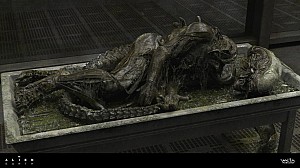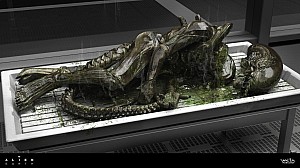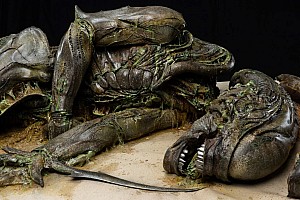(Possible Spoilers) Theories on AC Alien Life Cycle
Alien: Covenant Forum Topic
Akamsk
MemberOvomorphMay 20, 20174552 Views1 RepliesI've heard a lot of flack about the AC Xeno's maturation process, so I thought I'd just post my what I'd been thinking. This is more of just speculation.
I kind of feel like the changed gestation period is because this is a more "pure" form of the alien. Before the DNA gets diluted over many impregnations and DNA modification through multiple hosts. The maturation process would be more potent, and as a result it would take less time, providing a more developed xenomorph when it emerges. Basically, we see a chest burster because it is a very slowly developing alien. This pure Xeno develops very quickly and is only in the chestburster/snake stage for a fraction of the time, so arms, legs, and tails develop quickly after, earlier in the life cycle, and without a ribcage to contain it, it will rapidly grown once it emerges. This proto-xeno is more akin to the black goo, and still has those stem-cell properties, rapid cell growth and the ability to develop into many types of cells (for example, why a neo-morph could take a lot of damage and still seem fine). After a ton of DNA dilution through multiple hosts, the ratio of primortial goo to host DNA becomes more and more diluted, giving it less flexible qualities, and creating a longer gestation period as the species no longer needs to rapidly grow as a new, struggling to survive, life form. Incubation does not need to be as rapid, as it becomes more established as a species, especially once it develops a hive-like structure (Possibly a trait taken from a future host?) in which a matriarch can look after its children.
We know the xeno takes on characteristics from its host and incorporates them, and we saw in Prometheus how the goo went from a liquid to a infected sperm, to a fetal squid, to a giant starfish-hugger, to impregnate an engineer to make the deacon alien. That was just in the course of one life cycle, one "facehugger". And that decon came out fully developed as well, and relatively quickly, the larger engineer body allowing it to grow more before needing to burst. The Xenomorph we know is a far cousin to these early models, so it makes sense that they would be very different.
In Prometheus, David calls the goo "the accelerant". What is it accelerating? Cells decay quickly which causes instances like the engineer and Halloway's reactions, but it also then re-purposes that organic matter which is left, like how a decaying animals nutrients can be used to give live to another organism. This process that normally can take take months or even years, depending, can happen in mere seconds, with all the materials still in close proximity, allowing the newly reconstituted cells to specialize like stem cells, changing to match the matter around it, AKA the decomposing tissue that has yet to be broken down, creating a similar being to what it was originally, but heavily modified. Thus, the more "pure" the connection to the black goo, i.e. the fewer generation from initial contamination, the faster (accelerated?) the maturation of the product.
I'm also curious, do we think David ACTUALLY created those eggs? Or were they something these possible engineers found, and were already in that underground area. Like, did David just play with them? Perhaps they were where the goo was extracted from, and David simply took the eggs and huggers we all know (or an earlier variation), and enhanced the maturation process with the goo? Perhaps his experiments kind of failed and he took credit for the eggs as a way to compensate. Having already disposed of the Engineers, it would seem weird for him to develop a species which needs a host to survive, when he had none. It would make more sense that he would have found some form of the eggs preexisting.
Anyway, if you read through all of this, I appreciate your time, sorry for the no-doubt many spelling and grammatical missteps.
Replies to (Possible Spoilers) Theories on AC Alien Life Cycle
Hey Guest, want to add your say?
Are you an avid Alien fan looking for a dedicated online community of likeminded fans? Look no further! Create your own profile today and take part in our forums and gain XP points for all the content you post!









